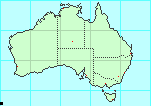
Common Name:
Delete this section if there is no common name.
Identification:
Length:
Coloring:
Note any distinguishing features.
volant; male and female mesopterous
body,
exclusive of cerci | 86 mm. |
| head | 5 mm.
width, 3 mm.
(behind eyes). |
| pronotum | 3 mm.
width, 2.3 mm. |
| mesonotum | 15 mm.
width, 1.5-4 mm. |
| metanotum | 13 mm.
width, 4 mm. |
| abdomen | 50 mm.
width, 1.5-2.5 mm. |
| ant. pedes | 61 mm. |
| med. pedes | 44 mm. |
| post. pedes | 62 mm. |
| tegmina | 10 mm.
width, 4 mm. |
| wings | 52 mm.
width, 22 mm. |
| cerci | 8 mm. |
Male.
Pale brown; body very slender.
Head glabrous: flat, with indistinct, whitish dots and lines above.
Occiput with two median depressions and curved impressed furrows on
each side.
Ocelli obsolete.
Antennæ densely hirsute.
Pronotum much shorter and narrower than the head, with some longitudinal
furrows, terminated by a transverse carina near hind margin.
Mesonotum cylindrical, gradually tapering to near base of elytra, then
rapidly expanding to more than double between median legs, thickly beset
with many small interspersed and some large spines.
Metanotum stout, glabrous, with three pairs of short, oblique, white
streaks underneath.
Legs very long and slender, all ridges with small, distant spinelets,
except those of the anterior tibiæ and of the tarsi.
Tegmina short and narrow, costa and a short, oblique, discal streak
whitish, remainder brown.
Wings long and rather narrow: costa with some small dark spots from
near middle to apex: veins and veinlets from pale to dark brown, some
of the former interruptedly black towards margin: veinlets bordered
with blackish-brown: outer margin broadly suffused with dull blackish,
likewise the costal part of the membranous disc, with irregular blotches,
the dark markings separated by translucent areas.
Abdomen very slender throughout: sexual organs, including respective
joint and lamina, also anal joints, very short and tumid.
Cerci broad, ovate, subacute, nearly as long as the preceding three
joints together.
The species is comparable with
Acrophylla tesselata, G.R.G., from N. Australia (Westwood,
Cat. Phasm. B.M., Plate xxxv., fig. 1), but is larger, and differs in the
paucity of the spinulation of the legs, colouration of the wings, etc.
There are a pair of similar insects in the collection from Central
Australia, but appear to differ in proportions.
 Note parental placement of eggs.
Note appearance of eggs.
Note any common variations.
Note parental placement of eggs.
Note appearance of eggs.
Note any common variations.
Habitat:
Note if the species arborial or terrestrial.
Canopy, mid, under, etc.
Note typical vegetation, e.g.
tropical rainforest, temperate rainforest,
grasslands,
alpine, etc.
Similar Species:
Rearing Notes:
Note if this species has ever been reared.
Note any suggestions for successful rearing.
For a stick insect with body length 86mm, to keep 2 adult females,
you need a cage at least 400mm high, 180mm deep and 180mm wide.
 Range:
Range:
W plateau, SA; known only from type locality
Status:
It is not known if this species is endangered,
as there is insufficient sighting history.
References:
-
Balderson, J., Rentz,
D.C.F. and Roach, A.M.E. (1998).
in
Houston, W.K.K. & Wells, A. (1998) (eds)
Zoological Catalogue of Australia.
Vol. 23.
Archaeognatha, Zygentoma, Blattodea, Isoptera, Mantodea, Dermaptera,
Phasmatodea, Embioptera, Zoraptera.
Melbourne: CSIRO Publishing, Australia (ISBN 0643 06035 9).
pp. 347 - 376.
-
Tepper, J.G.O. (1905).
Insects collected in the North-western Region of South Australia Proper
by H. Basedow; with Descriptions of New Species of Mantidæ and
Phasmidæ, No. 2.
Transactions of the Royal Society South Australia, 29: 237-245.
-
Vickery, V.R. (1983).
Catalogue of Australian stick insects (Phasmida,
Phasmatodea, Phasmatoptera, or Cheleutoptera). CSIRO
Australian Division of Entomology Technical Paper, No. 20, 15 pp.
- Search Google for
Acrophylla nubilosa,
or search Google Scholar for
Acrophylla nubilosa.
Copyright © 2000-2003
Peter Miller
This page was last changed 20-Sep-2006.
|

|

|
 Note parental placement of eggs.
Note appearance of eggs.
Note any common variations.
Note parental placement of eggs.
Note appearance of eggs.
Note any common variations.

 Note parental placement of eggs.
Note appearance of eggs.
Note any common variations.
Note parental placement of eggs.
Note appearance of eggs.
Note any common variations.
 Range:
Range: 
